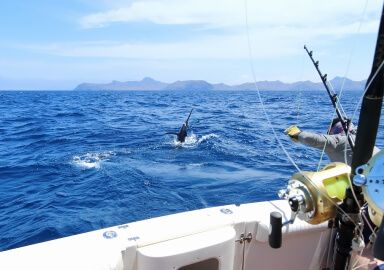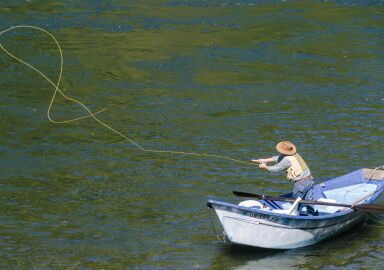Tilefish
Tilefish are large, deepwater bottom dwellers found off the U.S. East Coast, offering anglers a rewarding challenge and excellent table fare.
View 5 listings
5
listings
–
price starting from
1
countries
Where and When?
Great northern and bluelined tilefish are found along the eastern seaboard of North America, from the Nantucket Shoals in Massachusetts southward into the Gulf of Mexico. While other tilefish species exist in similar deepwater habitats worldwide, sport fishing for tilefish is primarily concentrated on these two species.
Tilefish inhabit the continental shelf, typically at depths of 76–457 meters (250–1,500 feet). Unlike many bottom-dwelling fish that seek out reefs or wreck, tilefish prefer flat, open seabeds, where they dig burrows to live and feed. These burrows are often located along canyon edges and drop-offs, but the fish do not rely on structure as many other deepwater species do.
Historically, tilefish populations suffered from overfishing, leading to a significant decline and an “endangered” status. However, strict regulations have helped stocks partially recover, and both recreational and commercial catches have increased in recent years. Tilefish can be caught year-round, though they tend to be more active during the summer months. The time of day is less important, as their deepwater habitat receives little to no light penetration.
About Tilefish
The name tilefish refers to various species within the Malacanthidae family. While many tilefish species are small and inhabit shallow waters, the ones most prized by sport anglers are the larger, deepwater varieties. The most notable of these is the great northern tilefish (Lopholatilus chamaeleonticeps), a striking fish with an iridescent blue-green back that takes on a pinkish hue during the spawning season. Another highly sought-after species is the bluelined tilefish (Caulolatilus microps), recognizable by its light greyish body and a distinctive blue-lined golden stripe running from its snout to its eye.
Both species share a streamlined, torpedo-like body shape with sloping foreheads, medium-sized eyes, and small but strong teeth designed for crushing hard-shelled prey. Males grow larger than females, with great northern tilefish reaching up to 1.12 meters (44 inches) and 30 kg (66 lbs.), while females grow slightly smaller, maxing out at around 1 meter (39 inches).
Tilefish are bottom dwellers that burrow into the seabed, preferring soft, sandy, or muddy substrates rather than rocky structures. They feed mainly on crustaceans such as crabs, lobsters, and bivalves, along with small fish. Unlike many offshore species, tilefish do not undertake large migrations. Spawning occurs throughout the summer, with females capable of laying up to 8 million eggs per year.
How to Catch?
Reaching tilefish fishing grounds requires a substantial boat capable of handling offshore conditions. Many charter operators along the U.S. East Coast specialize in tilefish trips, providing both the expertise and the specialized equipment needed for deepwater fishing. For anglers new to targeting tilefish, using the charter's gear can be a cost-effective and hassle-free option.
Locating tilefish is not always easy, as they tend to be concentrated in specific areas. Experienced captains use advanced sonar and GPS to pinpoint productive spots where tilefish burrows are abundant. Once in position, anglers need a deep-drop rod paired with a manual or electric high-capacity reel, as retrieving fish from extreme depths can be physically demanding.
Strong braided line is essential for detecting bites, as it does not stretch like monofilament. Tilefish strikes can be subtle, so sensitivity is key. A simple bottom rig with a 2–5 lb. sinker and a circle hook works best, allowing the bait to reach the bottom quickly and providing a secure hookset. Natural baits such as squid, crab, shrimp, or cut fish are highly effective, though some anglers have also found success using metal jigs.
The key to landing a large tilefish is a steady and controlled retrieval. Their mouths are not particularly strong, and aggressive or erratic reeling can cause the hook to tear free. Patience and a smooth, consistent motion will help bring the fish to the surface successfully.
Catching a large tilefish is a true deepwater accomplishment, rewarding anglers with an impressive photo, a great sense of achievement, and—perhaps best of all—an outstanding meal.





